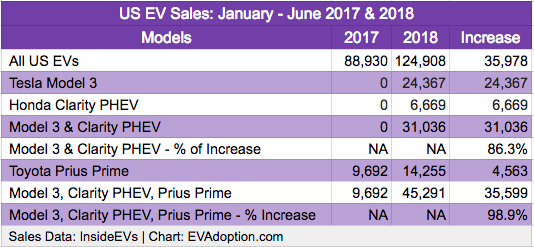In the first half of 2018, 86% of the YOY increase in new electric vehicle sales has come from just two models, the Tesla Model 3 and Honda Clarity PHEV.
Further, if you add in sales of the Toyota Prius Prime, then 3 models accounted for 98.9% of the YOY sales increase for the first 6 months of the year.
Similarly, if we look at EV sales for 2017 versus 2016, two models, the Chevrolet Bolt and Toyota Prius Prime, accounted for 100% of the EV sales growth. In 2016 the Bolt reached US dealers in December and the Prius Prime in November.
In 2016, EV sales increased 42,515 units over 2015. One EV, the Tesla Model X, which reached the US market in September 2015, (but only sold 214 units in 2015) sold 18,223 in 2016. The Model X then was responsible for 43% of the sales increase in 2016 over 2015.
If you go back to 2015, sales of EVs in the US actually declined by 6,339 units to 116,099 from 122,438 in 2014. The lack of growth was primarily due to there not being any new high-volume selling EVs introduced in late 2014 or early 2015.
There were 6 new models introduced in July 2015 or later and 5 of which sold less than 250 units and the BMW X5 xDrive40e only sold 892 units. There were also no new EVs introduced in the last few months of 2014. And those reaching the market earlier also contributed very little to 2015 sales growth.
The data is pretty clear then, that to date EV sales growth each year comes mostly from the introduction of a few new strong-selling EVs early in the year or late in the previous year.
Without a few good-selling (e.g., 1,000-3,000 or more per month on average) EVs being introduced or on the rise from a previous year, EV sales tend to remain basically flat. The implication, at least in the near term, is that most EV models have a sales plateau.
In the next post, Sales Growth of US EV Models Peaks After 3 Full Years on the Market, I share new analysis of sales trends for top selling EVs.



